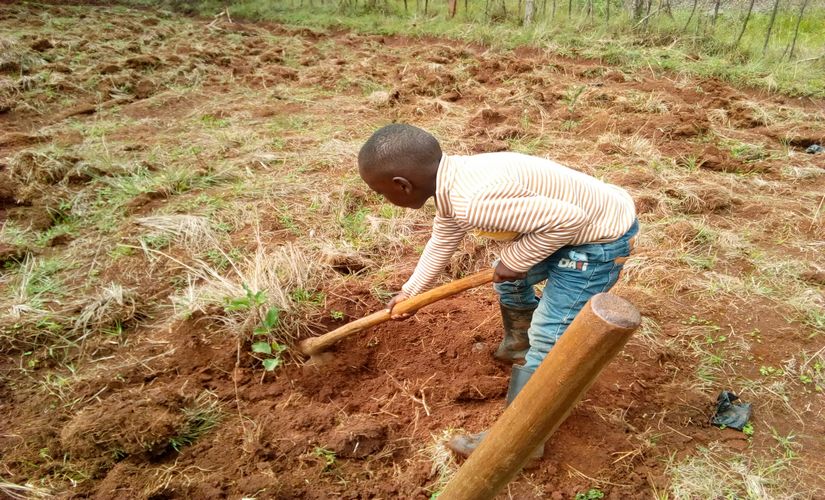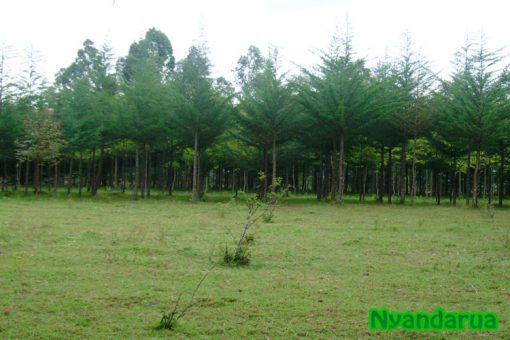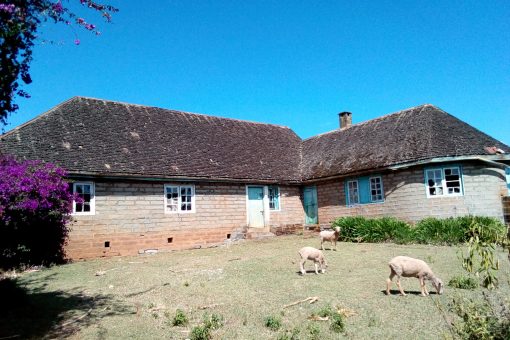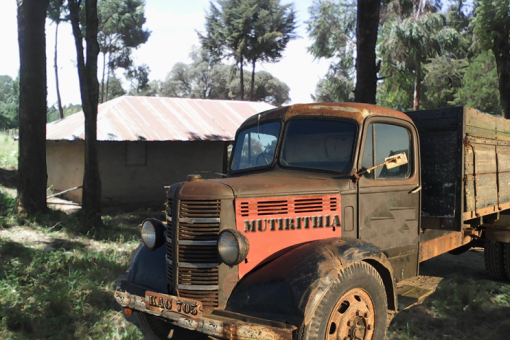Children were a free labor, gifted to parents by God. Our relationship with our parents was simple. We worked the land, did as we were told, and in return we got to live in their home. They provided our basic needs and gave us an education. That was the unspoken deal.
From the struggles our parents went through during their youth under colonial rule, they did not want their children to have to struggle the same way in an independent country. They knew we now stood a chance of a good education, empowering us and opening doors of opportunities they never had. But, they needed us to understand hard work. For the farm to produce anything worth selling, somebody needed to put time and sweat into it. Our parents could not do it alone. We were the only helpers they had, since there were not many laborers in OlKalou looking for work, and most parents could not afford them anyway. The Pioneer parents needed to save every penny they got, to make their monthly mortgage payments otherwise they risked defaulting and losing their farms, a risk that none of them was willing to take.
As children, we did not understand that fact, and we always wondered why our parents worked us like donkeys. We viewed them more as slave drivers (nyafara). We worked so hard, all day long, every day, but there was never a thank you or well done. Majority of parents did not offer such compliments back then. I know mine did not. Never. I guess their reasoning was that: we were simply carrying out our responsibility of developing “our” land, NOT doing them any favors that we needed to be thanked for. We did not understand them back then, but now, I understand them completely. What were their options? What could I have done in their circumstances? The end justifies the means.
As second generation Nyandaruans, now owning portions of that land our parents feared they would lose before they paid it off, I now feel proud that I was there to help develop the farm. We ‘bought’ the land alongside our parents, and that is why we can now own Nyandarua with pride. Without knowing, we worked hard from childhood to make our Pioneer Parents dream come true, and in the process we secured our own future as they dreamed it for us when they first stepped foot in Nyandarua back in the 1960s.
Tree Planting: Today, when I look around our farm and see some unbelievably tall Blue Gum and Cypress trees swaying in the wind, trees that are almost 40 years old, first I am hit by a sting of nostalgia. I wonder where time went because in my mind, those are trees we just planted the other day after coming home from school, Munyeki Primary. My father always loved trees. We planted them by the thousands throughout our childhood, although our farm was already full of thick natural indigenous forest. Before there was a government order to get a permit from the local Chief before cutting down a tree, my father was ahead of the curve. Nobody, including my mother could cut down a tree unless my father approved of it. He was the “Chief” and we all knew his stand on that subject. My mother gave advance notice whenever she needed a tree cut down for firewood or charcoal. My father went around the farm and earmarked the tree that could be felled. That was usually the old, crooked unsightly tree, never the majestic looking beauties. For firewood, we had mainly depended on branches pruned from those indigenous trees, but sometimes mother needed a full tree to stock up firewood for months at a time, putting them under a shed to dry out completely over time, making them perfect for a roaring fire with minimal smoke. My mother could not tolerate homes where half dried, recently chopped firewood was used for cooking, smoking all over the kitchen, making food, especially tea taste of smoke.
Our childhood was marked with our father coming home around 5pm. He always had something to be unloaded from the bed of his pick up truck. Some days it was animal feed, other days it was dog food, produce from Gikuyu, fertilizer and seeds, barbed wire, galvanized iron sheets or anything farm related. We had no problem unloading any of those items. We unloaded quickly and moved on with our business.
The one thing we hated to see on the bed of the pick up truck were tree seedlings. Back in the day, tree seedlings came in wooden crates, not in individual black polythene bags like most nurseries plant them today. The best time for planting trees was during the long rains that usually started in April. That coincided with our month long school holiday, providing my parents with the labor force they needed to work the farm. We worked from sun up to sun down, planting all kinds of crops to fill 10 or more acres. When that was done, our father knew it was time to start bringing the trees in installments. He brought Blue Gum (Minyua Maai), Cypress (Mithithinda) Red Cider (Mitarakwa) and Pine (Michinda Nugu). As I mentioned in earlier posts, Nyandarua rain usually started falling in late afternoon, meaning when our father pulled up at the gate between 4 and 5pm, chances are the rain had already started. That was his whole point. He wanted the trees to be planted in the rain for better results. On arrival, he found us in the kitchen warming ourselves by the fire, after a full day of hard work on the farm with our mother. He called from outside “nikii mureeka nyumba muthenya?” translation, “what are you doing inside the house during day time?” That was a rhetorical question that required no answer. It was code for, “I need you all outside, I have work for you” On checking the bed of his pick up, it was full of tree seedlings, beautiful, healthy, leafy seedlings waving in the rain. We knew what that meant. Those seedlings had to be planted TODAY in the rain or hail storm (mbura ya mbembe). We knew the drill.
D.A.P fertilizer came in some very tough plastic bags that we recycled after using the fertilizer for planting our food crops on some 10 plus acres, over 20 acres of wheat, 5 acres of oats for the cows and 2 acres of nappier grass (thaara). That meant there was never a shortage of those empty bags, they were piled up high in one section of our granary (ikumbi). We knew how to use them as rain ponchos since umbrellas were not readily available, and there was no way to work holding an umbrella in one hand anyway. Our best and only option was the tough, durable D.A.P. fertilizer bags. We were smart enough not to use the inside part of the bag that still had fertilizer dust in it. So, this is how we turned the bags into rain ponchos. We held the bag upside down, the open side facing down. From one corner of the sealed side, we pushed it in, tucking it into the inside of the other corner, reducing the bag into half and forming a canopy. The canopy is what we put over our heads as the rest of the bag covered our backs.
Our father always brought six crates of tree seedlings at a time. I wonder why? Anyhow, the six of us grabbed a crate each, a gallon (mukebe) or kiondo of fertilizer each and a jembe for digging the holes. Have you ever tried digging a hole in the ground on virgin land? Try it sometime and see how you like it. Anyhow, we were directed to whichever fence our father wanted the trees planted. Every fence on our farm had to have a line of trees along it, and there were so many fences all over the farm. We knew how many tree seedlings to plant between two fence posts (ikingi), usually one or two depending on their spacing. So, while other children were running indoors to shelter from the rain, us, we were headed out to plant trees.
Woe unto us if the rains stopped for a few days after we planted the trees. After school, each one of us carried jerricans of water to water the trees we planted. Everybody knew their portion, and none of us wanted any of “their” trees to wilt or dry up because that meant, you will be brought another full crate of seedlings to replace the ones you lost and you will be given another portion to plant the remaining trees, extending your territory of seedlings to nurture. To avoid a repeat job and a lecture, we tended to “our” trees until they took hold. We did that every year until every fence on our farm had trees on it. It was very rare to lose a single seedling. They all made it into the gigantic trees we watch with fascination and pride today, almost 40 years later.
Today, we now appreciate the lessons my father taught us from a very early age and for most of us, we have carried forward the tradition of planting, nurturing and valuing trees. Wangari Mathaai would have been very proud of my father and the “green children” he raised. That is how our parents trained us, their children, to value the land they had acquired with nothing but hope and Faith, hoping those values would rub off on us and help us carry Nyandarua into a future of prosperity and promise.
Here we are folks, decades later, witnessing the results of hard work from 40 years ago. Whenever I contact the real local Chief for a permit to fell down one of those gigantic trees for fencing or construction needs, my heart wells with gratitude to my parents for their foresight. I also feel great pride and sense of ownership when I get to use the end product of those trees because I know our fingerprints, my brothers and I, are on each one of those trees. We can borrow a leaf from our Pioneer Parents and instill hard work in our children today and in 40 years from now, God willing they will look back with pride, just as we are appreciating work our parents taught us to do 40 years ago. Time waits for no man. Lets utilize it effectively today and there will be no regrets awaiting us and our children in the future. We are Nyandarua strong. We can do it.




